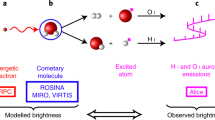Abstract
Comets are the most primordial objects in our solar system. Comets are icy bodies that release gas and dust when moving close to the Sun. The C/2020 F3 (Near-Earth Object Wide-field Infrared Survey Explorer: NEOWISE) is a nearly isotropic comet moving near-parabolic orbit. The C/2020 F3 (NEOWISE) was the brightest comet in the northern hemisphere after comet Hale–Bopp in 1997 and comet McNaught in 2006. This paper presents the first interferometric high-resolution detection of the comet C/2020 F3 (NEOWISE) using the Giant Metrewave Radio Telescope (GMRT). We detected the radio continuum emission from the comet C/2020 F3 (NEOWISE) with a flux density level 2.84 (±0.56)–3.89 (±0.57) mJy in the frequency range of 1050–1450 MHz. We also detected the absorption line of atomic hydrogen (HI) with a signal-to-noise ratio (SNR) \(\sim \)5.7. The column density of the detected HI absorption line is \(N_{\textrm{HI}} = (3.46\pm 0.60)\times (T_{s}/100)\times 10^{21}\,\hbox {cm}^{-2}\), where we assume the spin temperature \(T_{s} = 100\) K and filling factor \(f = 1\). The significant detection of continuum emission from the comet C/2020 F3 (NEOWISE) at \(\sim \)21 cm wavelength indicated that it arose from the large icy grains halo (IGH) region.




Similar content being viewed by others
References
Altenhoff W. J., Batrla W., Huchtmeier W. K. et al. 1983, A &A, 125, L19
Altenhoff W. J., Huchtmeier W. K., Schmidt J. et al. 1986, A &A, 164, 227
Altenhoff W. et al. 1999, A &A, 348, 1020
Bauer J. M., Mainzer A., Gicquel A. et al. 2020, American Astronomical Society, DPS Meeting #52, id.316.04
Biermann L., Trefftz E. 1964, ApJ, 59, 1
Biraud F., Bourgois G., Crovisier J. et al. 1974, A &A, 34, 163
Chengalur J., Kanekar N., Roy N. 2013, MNRAS, 432, 3074
Combi M. R., Mákinen T., Bertaux J. L., Quémerais E., Ferron S. 2021, ApJ, 907, 2
Cornwell T. J., Golap K., Bhatnagar S. 2008, IEEE J. Sel. Top. Signal Process., 2, 647
Code A. D., Houck T. E., Lillie C. F. 1970, IAU Circular No. 2201
Code A. D. 1972, NASA SP-310, 109
Crovisier J., Schloerb F. P. 1991, Kluwer Academic Publishers, 149
Crovisier J. 1989, A &A, 213, 459
Crovisier J., Colom J., Gerard E., Bockelee-Morvan D., Bourgois G. 2002, A &A, 1053
Crovisier J., Bockelee-Morvan D., Colom P., Biver N. 2016, Comptes Rendus Physique, 17, 985
de Pater I., Wade C. M., Houpis L. L. F., Palmer P. 1985, Icarus, 62, 349
de Pater I., Palmer P., Snyder L. E., Ip W.-H., 1986, The Exploration of Halley’s Comet, Vol. 1, 409
de Pater I., Palmer P., Snyder L. E. 1991, Kluwer Academic Publishers, 175
Dobrovolski O. V. 1958, Bull. Astrofiz. Akad. Nauk, Tadzh, SSR, p. 26
Giorgini J. D. 2017, IAU General Assembly
Greenberg J. M., 1982, University of Arizona Press, 131
Hobbs R. W., Maran S. P., Brandt J. C, Webster W. J., Swamy K. S. K. 1975, ApJ, 749
Hobbs R. W., Brandt J. C., Maran S. P. 1977, ApJ, 218, 573
Kitamura Y., Ashihara O., Yamamoto T. 1985, Icarus, 2, 278
Makinen T. 2001, Finnish Meteorological Institute, 1
Manzini F., Oldani V., Ochner P. et al. 2021, MNRAS, 506, 6195
McCoy R. P., Opal C. B., Carruthers G. R. 1986, The Exploration of Halley’s Comet, Vol. 1, 403
McMullin J. P., Waters B., Schiebel D. et al. 2007, ASP. SanFrancisco, CA, p. 127
Paris A. 2017, J. Wash. Acad. Sci., 103, 1
Perley R. A., Butler B. J. 2017, ApJ, 230, 1538
Rau U., Cornwell T. J. 2011, A &A, 532, A71
Rivilla V. M., Beltran M. T., Cesaroni R. et al. 2017, A &A, 598, A59
Smith A. J., Anish Roshi D., Manoharan P. et al. 2021, PSJ, 2, 123
Turner B. E. 1974, ApJ, 189, L137
Vastel C., Bottinelli S., Caux E., Glorian J. M., Boiziot M. 2015, in SF2A-2015: Proceedings of the Annual meeting of the French Society of Astronomy and Astrophysics, p. 313
Weintraub D. A., Sandell G., Duncan W. D. 1989, ApJL, 340, L69
Whipple F. H. 1950, ApJ, 375
Acknowledgements
We thank the anonymous referees for their helpful comments that improved the manuscript. AM acknowledges the Swami Vivekananda Merit cum Means Scholarship (SVMCM), Government of West Bengal, India, for the financial support of this research. The plots within this paper and other findings of this study are available from the corresponding author upon reasonable request. We thank the staff of GMRT for their assistance. We acknowledge Ruta Kale for her support during the observation of the comet NEOWISE. The raw data of NEOWISE reported in this paper are available through the GMRT archive with the proposal code ddtC141. This radio telescope is operated by the National Centre for Radio Astrophysics, which is part of the Tata Institute of Fundamental Research.
Author information
Authors and Affiliations
Corresponding author
Rights and permissions
Springer Nature or its licensor (e.g. a society or other partner) holds exclusive rights to this article under a publishing agreement with the author(s) or other rightsholder(s); author self-archiving of the accepted manuscript version of this article is solely governed by the terms of such publishing agreement and applicable law.
About this article
Cite this article
Pal, S., Manna, A. Detection of continuum emission and atomic hydrogen from comet C/2020 F3 NEOWISE using GMRT. J Astrophys Astron 45, 10 (2024). https://doi.org/10.1007/s12036-024-09998-4
Received:
Accepted:
Published:
DOI: https://doi.org/10.1007/s12036-024-09998-4




